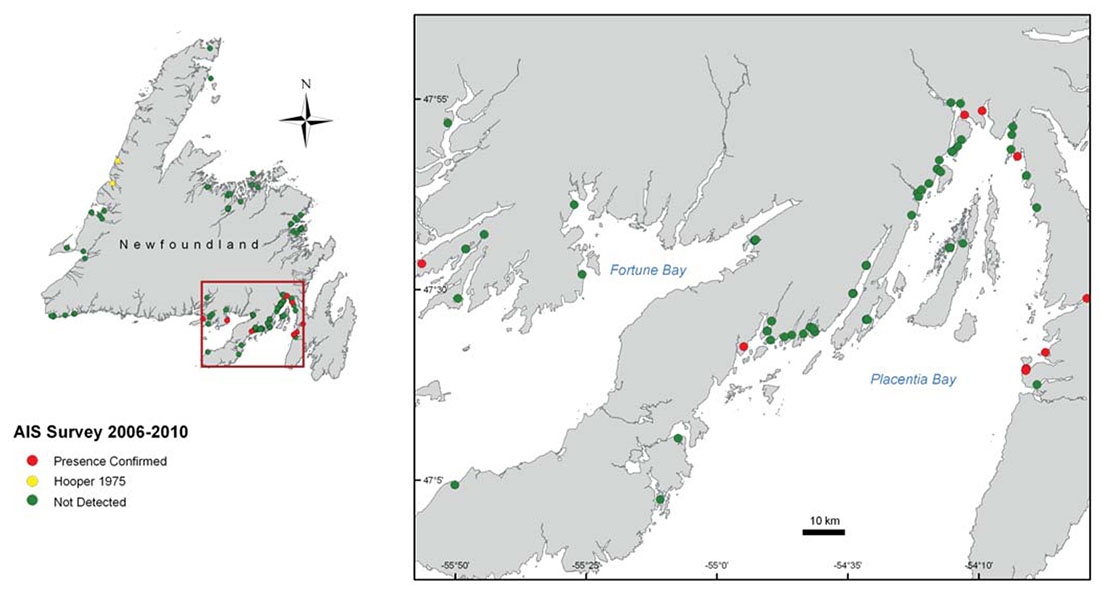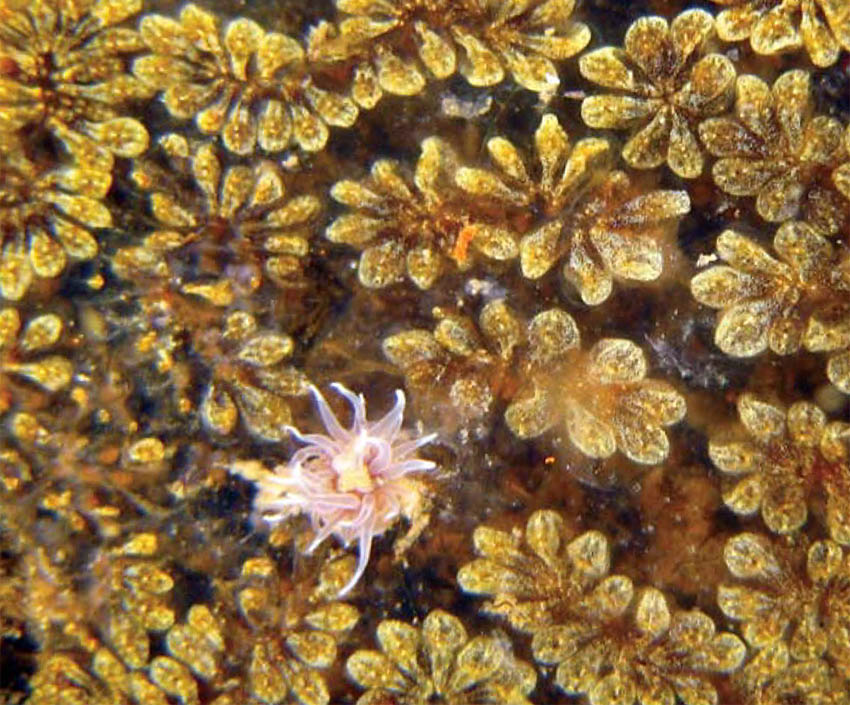Golden Star Tunicate in Newfoundland and Labrador Waters
Tunicates are aquatic animais with a sac-like body protected by a coat or 'tunic'. They may live in large colonies and feed by filtering sea water through their bodies. Researchers think that tunicates first appeared over 500 million years ago.
Tunicates are found on ail continents except Antarctica, and it is believed that the golden star tunicate (Botryllus schlosseri) likely originated in the Mediterranean Sea. It was discovered in North America around 1870, and was first identified in Newfoundland and Labrador in 1975 (see map).
Golden star tunicate colonies often grow up to 10 cm in diameter. They can be distinguished from other types of tunicates by the star-shaped arrangement of individuals within a clear, firm, coat or tunic. Despite their name, they can be many different colours and patterns. Colonies are typically densely packed into a mat that covers the underlying surface. Where space is limited, they may grow in lobes, with single layers of individuals folding over one another.
The golden star tunicate reproduces in two ways: when fragments of a colony break off and bud elsewhere, and by the production of eggs that hatch into free-swimming larvae. Both fragments and larvae settle and grow on a range of artificial surfaces such as buoys, boat hulls, rope, wharf pilings, and floating docks as well as on natural surfaces such as rocks, mussels and kelp.
Larvae released into the water column settle within 24 to 48 hours, and only travel over small distances. Colony fragments may reproduce for up to 40 days and may disperse over much greater distances.
Colonies grow once water temperatures exceed 6° C. Egg production, larval development, and growth start at water temperatures greater than 12 C. During the winter, when water temperatures drop below 6° C, colonies may enter a resting phase, reduce in size or die.
Environmental Impact of Golden Star Tunicate
Golden star tunicate is a filter feeder, getting nutrients from phytoplankton (algae), bacteria and other small organic things that float in the sea. In large numbers, the tunicate competes for food with other filter feeders, such as mussels and scallops.
Golden star tunicate is mostly composed of water. It grows rapidly and may cover surrounding plants and animais, depriving them of sunlight or food. Golden star tunicate may even suffocate smaller organisms such as juvenile mollusks, and may cause organisms that attach to marine surfaces to be more vulnerable to being moved by water currents. All of this makes the golden star tunicate disruptive to shellfish harvesters, aquaculture farmers, and aquatic organisms that live on the bottom of the ocean.
Discovery and Survey Findings
Golden star tunicate was first reported in Bonne Bay, on the west coast of Newfoundland and Labrador, around 1975. Approximately 30 years later, this species was confirmed at a number of sites along the south coast of insular Newfoundland. Fortunately, this species has not yet been reported in local mussel farms, but it has been seen growing well on wharf structures, ship hulls, plastic buoys, kelp, and wild mussels.
As the ocean grows warmer, it is important to continue to monitor any changes in the golden star tunicate's distribution and range expansion. Titis will help to prevent and manage its spread.
Golden Star Tunicate Distribution in Newfoundland Waters

AIS Survey 2006-2010
- Argentia: Placentia Bay
- Arnolds Cove: Placentia Bay
- Baine Harbour: Placentia Bay
- Bonne Bay: Bonne Bay
- Codroy: Southwest Coast
- Fox Harbour: Placentia Bay
- Foxtra: Conception Bay
- Garden Cove: Placentia Bay
- Harbour Breton: Fortune Bay
- Hermitage: Hermitage Bay
- Kingwell: Placentia Bay
- Lamaline: Placentia Bay
- Little Bay: Placentia Bay
- Little St Lawrence: Placentia Bay
- Long Harbour: Placentia Bay
- Long Pond: Conception Bay
- Northeast Arm Placentia: Placentia Bay
- North Harbour: Placentia Bay
- North Tilt Island: Placentia Bay
- Southeast Arm Placentia: Placentia Bay
- Spencers Cove: Placentia Bay
- St. Pauls Inlet: Northern Peninsula West
- Swift Current: Placentia Bay
Methods to Control the Spread of Golden Star Tunicate
Tunicates can spread through the movement of fishing gear, shellfish, and recreational and commercial vessels. To control the spread of golden star tunicate, boat hulls and fishing gear should be visually inspected and cleaned when necessary.
To prevent the spread of living fragments, water inside boats should be cleaned out and the boat should be allowed to dry for 24 hours. Also, because golden star tunicate can rapidly colonize and establish large, self-sustaining populations, it should be removed from wharves and surrounding structures.
When combined with surveys (see map), using genetic tools to find eggs and larvae of golden star tunicate will help target control and prevention efforts. Improving our understanding of its lifecycle will helps us to establish where and when to apply these efforts. Especially important is the removal of golden star tunicate before it reproduces each year. Recent work by Memorial University of Newfoundland and Fisheries and Oceans Canada at Amold's Cove indicate that the reproductive cycle starts in late July and continues through early October.
References
- Berrill, N.J. 1950. The Tunicata, with an account of the British species. Ray Society, London. Publication 133: iii + 354 p.
- Callahan, A.G., Deibel, D., McKenzie, C.H., Hall, J.R., et Rise, M.L. 2010. Survey of harbours in Newfoundland for indigenous and non-indigenous ascidians and an analysis of their cytochrome c oxidase I gene sequences. Aquat Inv 5: DOI 10.339/ai 2010.5.1.
- Carver, C.E., Mallet, A.L., et Vercaemer, B. 2006. Biological synopsis of the colonial tunicates, Botryllus schlosseri and Botrylloides violaceus. Can Mans Rep Fish Aquatic Sci, 2747, MPO. 42 p.
- Hooper, R. 1975. Bonne Bay marine resources. An ecological and biological assessment. Mans Rep, Parks Can Atl Reg Office. 295 p.
© Her Majesty the Queen in Right of Canada, 2011
2011 DFO/2011-1720
Cat. No.: Fs23-555/2-2011E-PDF
ISBN: 978-1-100-18100-4
- Date modified:

